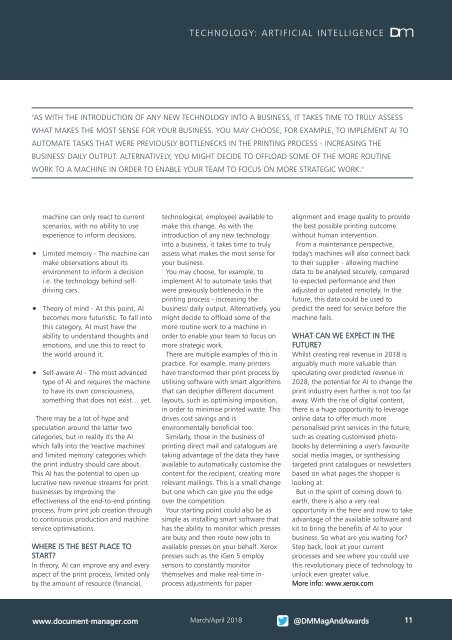Create successful ePaper yourself
Turn your PDF publications into a flip-book with our unique Google optimized e-Paper software.
TECHNOLOGY: ARTIFICIAL INTELLIGENCE Dm<br />
"AS WITH THE INTRODUCTION OF ANY NEW TECHNOLOGY INTO A BUSINESS, IT TAKES TIME TO TRULY ASSESS<br />
WHAT MAKES THE MOST SENSE FOR YOUR BUSINESS. YOU MAY CHOOSE, FOR EXAMPLE, TO IMPLEMENT AI TO<br />
AUTOMATE TASKS THAT WERE PREVIOUSLY BOTTLENECKS IN THE PRINTING PROCESS - INCREASING THE<br />
BUSINESS' DAILY OUTPUT. ALTERNATIVELY, YOU MIGHT DECIDE TO OFFLOAD SOME OF THE MORE ROUTINE<br />
WORK TO A MACHINE IN ORDER TO ENABLE YOUR TEAM TO FOCUS ON MORE STRATEGIC WORK."<br />
machine can only react to current<br />
scenarios, with no ability to use<br />
experience to inform decisions.<br />
Limited memory - The machine can<br />
make observations about its<br />
environment to inform a decision<br />
i.e. the technology behind selfdriving<br />
cars.<br />
Theory of mind - At this point, AI<br />
becomes more futuristic. To fall into<br />
this category, AI must have the<br />
ability to understand thoughts and<br />
emotions, and use this to react to<br />
the world around it.<br />
Self-aware AI - The most advanced<br />
type of AI and requires the machine<br />
to have its own consciousness,<br />
something that does not exist… yet.<br />
There may be a lot of hype and<br />
speculation around the latter two<br />
categories, but in reality it's the AI<br />
which falls into the 'reactive machines'<br />
and 'limited memory' categories which<br />
the print industry should care about.<br />
This AI has the potential to open up<br />
lucrative new revenue streams for print<br />
businesses by improving the<br />
effectiveness of the end-to-end printing<br />
process, from print job creation through<br />
to continuous production and machine<br />
service optimisations.<br />
WHERE IS THE BEST PLACE TO<br />
START?<br />
In theory, AI can improve any and every<br />
aspect of the print process, limited only<br />
by the amount of resource (financial,<br />
technological, employee) available to<br />
make this change. As with the<br />
introduction of any new technology<br />
into a business, it takes time to truly<br />
assess what makes the most sense for<br />
your business.<br />
You may choose, for example, to<br />
implement AI to automate tasks that<br />
were previously bottlenecks in the<br />
printing process - increasing the<br />
business' daily output. Alternatively, you<br />
might decide to offload some of the<br />
more routine work to a machine in<br />
order to enable your team to focus on<br />
more strategic work.<br />
There are multiple examples of this in<br />
practice. For example, many printers<br />
have transformed their print process by<br />
utilising software with smart algorithms<br />
that can decipher different document<br />
layouts, such as optimising imposition,<br />
in order to minimise printed waste. This<br />
drives cost savings and is<br />
environmentally beneficial too.<br />
Similarly, those in the business of<br />
printing direct mail and catalogues are<br />
taking advantage of the data they have<br />
available to automatically customise the<br />
content for the recipient, creating more<br />
relevant mailings. This is a small change<br />
but one which can give you the edge<br />
over the competition.<br />
Your starting point could also be as<br />
simple as installing smart software that<br />
has the ability to monitor which presses<br />
are busy and then route new jobs to<br />
available presses on your behalf. Xerox<br />
presses such as the iGen 5 employ<br />
sensors to constantly monitor<br />
themselves and make real-time inprocess<br />
adjustments for paper<br />
alignment and image quality to provide<br />
the best possible printing outcome<br />
without human intervention.<br />
From a maintenance perspective,<br />
today's machines will also connect back<br />
to their supplier - allowing machine<br />
data to be analysed securely, compared<br />
to expected performance and then<br />
adjusted or updated remotely. In the<br />
future, this data could be used to<br />
predict the need for service before the<br />
machine fails.<br />
WHAT CAN WE EXPECT IN THE<br />
FUTURE?<br />
Whilst creating real revenue in 2018 is<br />
arguably much more valuable than<br />
speculating over predicted revenue in<br />
2028, the potential for AI to change the<br />
print industry even further is not too far<br />
away. With the rise of digital content,<br />
there is a huge opportunity to leverage<br />
online data to offer much more<br />
personalised print services in the future,<br />
such as creating customised photobooks<br />
by determining a user's favourite<br />
social media images, or synthesising<br />
targeted print catalogues or newsletters<br />
based on what pages the shopper is<br />
looking at.<br />
But in the spirit of coming down to<br />
earth, there is also a very real<br />
opportunity in the here and now to take<br />
advantage of the available software and<br />
kit to bring the benefits of AI to your<br />
business. So what are you waiting for?<br />
Step back, look at your current<br />
processes and see where you could use<br />
this revolutionary piece of technology to<br />
unlock even greater value.<br />
More info: www.xerox.com<br />
www.document-manager.com<br />
March/April 2018<br />
@DMMagAndAwards<br />
11

















